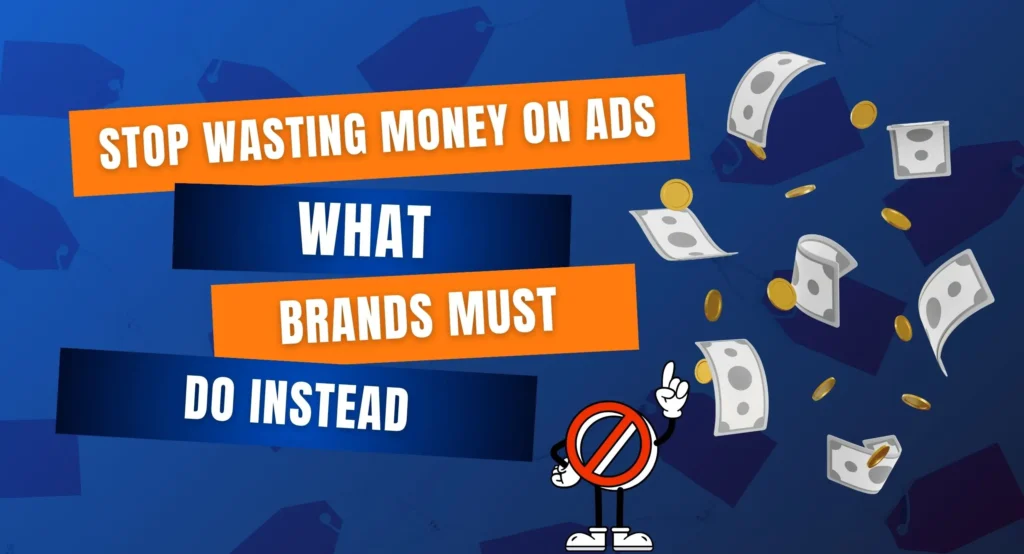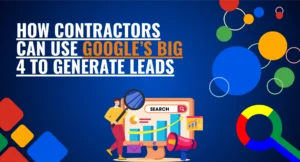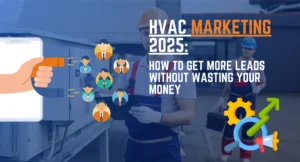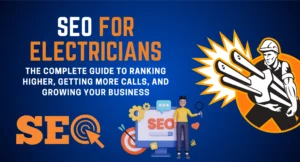Introduction
The Harsh Reality of Ad Spend
Every year, businesses collectively spend billions of dollars on advertising. From Google Ads and Facebook campaigns to boosted Instagram posts and display ads, the promise is the same: “Reach more customers, get more clicks, and grow your business.” But here’s the uncomfortable truth — most businesses are wasting money on ads. Instead of generating steady leads and revenue, ad budgets vanish with little to show in return.
The problem isn’t that advertising doesn’t work. In fact, well-run ad campaigns are still one of the fastest ways to drive targeted traffic. The real issue is that too many businesses — especially small businesses and those in the construction industry — approach ads without a strategy. They spend money on clicks without optimizing their websites, without tracking conversions, and without aligning campaigns to actual customer needs.
Why Businesses Keep Wasting Money on Ads
For many owners, ads seem like the quick fix. Traffic dips? Run some ads. Competitors show up higher in search results? Run more ads. Sales are slow? Increase the budget. The assumption is that more spend equals more results. But that’s rarely true.
Without the right foundation, increasing ad spend is like pouring water into a leaky bucket. You might generate clicks, but if your website is outdated, slow, or confusing, visitors leave without contacting you. This is especially true in construction marketing, where trust and credibility are everything. If a homeowner clicks an ad for a roofing contractor but lands on a site with no photos, no testimonials, and no clear call-to-action, they won’t convert — the money is gone, and the opportunity is wasted.
The Construction Industry’s Unique Challenge
For contractors, remodelers, and home service businesses, advertising waste is even more painful. Unlike e-commerce brands that might survive on impulse buys, construction projects involve high-ticket decisions. Homeowners research extensively before hiring, and they want proof that they’re dealing with professionals they can trust.
This means that every wasted ad click is costly. If you’re spending $10 per click on “kitchen remodeling near me” and none of those clicks turn into calls, you could easily burn through thousands each month. The bigger issue? Many construction companies don’t realize what’s going wrong — they assume ads don’t work, when in reality, it’s the landing page, targeting, or strategy that’s broken.
Why This Blog Matters
The purpose of this blog is to stop that cycle. By the time you finish reading, you’ll understand:
- The most common mistakes that lead to businesses wasting money on ads.
- Why web design and conversion optimization are critical to ad success.
- How smarter targeting can reduce wasted spend.
- Why tracking ROI matters more than impressions or clicks.
- Action steps you can take today to fix your ad campaigns and start seeing real results.
This isn’t about chasing shiny new ad platforms or throwing more money at the problem. It’s about understanding where the leaks are in your marketing system and fixing them so every dollar counts.
The Bottom Line
Advertising can work — but only when it’s built on a strong foundation. Without the right strategy, you’re not just spending money; you’re wasting money on ads that never had a chance to deliver. For businesses in competitive fields like construction, that waste can be the difference between steady growth and struggling to keep up.
In the sections ahead, we’ll break down the most common pitfalls and, more importantly, show you how to fix them. Because ads shouldn’t be an expense you dread — they should be an investment that drives consistent, measurable results.
The Harsh Truth About Advertising Waste
Advertising is supposed to generate results. The logic is simple: spend money, attract attention, get customers. Yet in reality, countless businesses find themselves wasting money on ads. Campaigns go live, budgets are drained, and at the end of the month, there are few (if any) qualified leads to show for it.
This isn’t a small issue. Studies have shown that as much as 25% to 40% of ad spend is wasted because of poor targeting, weak websites, or lack of follow-up systems. That means if a business spends $5,000 a month on digital advertising, anywhere from $1,250 to $2,000 might be delivering no measurable return. For smaller businesses like construction companies, that level of waste can seriously impact cash flow and growth.
The Illusion of “More Spend Equals More Results”
One of the biggest misconceptions about advertising is that more budget automatically means more leads. Unfortunately, without the right strategy, doubling your ad spend often just doubles your waste. If you’re wasting money on ads because of a broken foundation, increasing spend won’t fix the problem. It will magnify it.
For example:
- A contractor runs Google Ads targeting “home remodeling” but sends clicks to a generic homepage with no clear call-to-action. Even if they get 200 clicks a month, most visitors leave without requesting a quote.
- A roofing company boosts Facebook posts without narrowing the audience. The ads are shown to thousands of people outside their service area, generating likes but no qualified leads.
- A painting contractor invests heavily in display ads, but their website loads too slowly on mobile devices. Visitors abandon the page before it even finishes loading.
In each scenario, the business owner sees traffic but not results. The ad platform happily takes their money, but without fixing the underlying issues, the campaign is just another example of wasting money on ads.
Why Small and Mid-Sized Businesses Are Hit Hardest
Larger corporations can absorb advertising waste. They have bigger budgets, wider audiences, and entire teams dedicated to campaign optimization. For small and mid-sized businesses — particularly those in construction — every dollar matters.
Construction marketing is especially vulnerable because:
- High Cost per Click (CPC): Keywords like “roof repair near me” or “kitchen remodeling” can cost $10–$30 per click in competitive markets. Wasting even 50 clicks a month adds up fast.
- Long Sales Cycles: Unlike e-commerce, where ads can generate instant sales, construction leads often take weeks or months to close. This makes ROI harder to measure, and wasted spend can go unnoticed.
- Local Service Areas: Many contractors run ads too broadly, paying for clicks from people outside their geographic reach.
These factors mean that wasting money on ads isn’t just a nuisance — it’s a serious drain on resources that could otherwise fund better tools, staff, or project equipment.
Vanity Metrics vs. Real Results
Another harsh truth is that many businesses judge ad campaigns by vanity metrics: impressions, clicks, or likes. While these numbers look good on paper, they don’t always translate into leads or revenue.
For instance, a remodeling company may celebrate getting 5,000 clicks from a Google Ads campaign. But if their site doesn’t have a dedicated landing page for remodeling services, those visitors may never request a consultation. The business is essentially wasting money on ads that generate traffic without conversions.
The only metrics that matter are:
- Phone calls received.
- Quote requests submitted.
- Contracts signed.
Without tracking these outcomes, businesses risk celebrating empty numbers while losing money month after month.
The Bottom Line of Advertising Waste
Advertising isn’t broken. In fact, it remains one of the most effective tools for generating business growth. The problem is how ads are being used. Too many companies throw money at campaigns without fixing their websites, refining their targeting, or measuring ROI. The result is predictable: frustration, disappointment, and wasted budgets.
The harsh truth is this: unless businesses build the right foundation, they will continue wasting money on ads that never had a chance of delivering results.
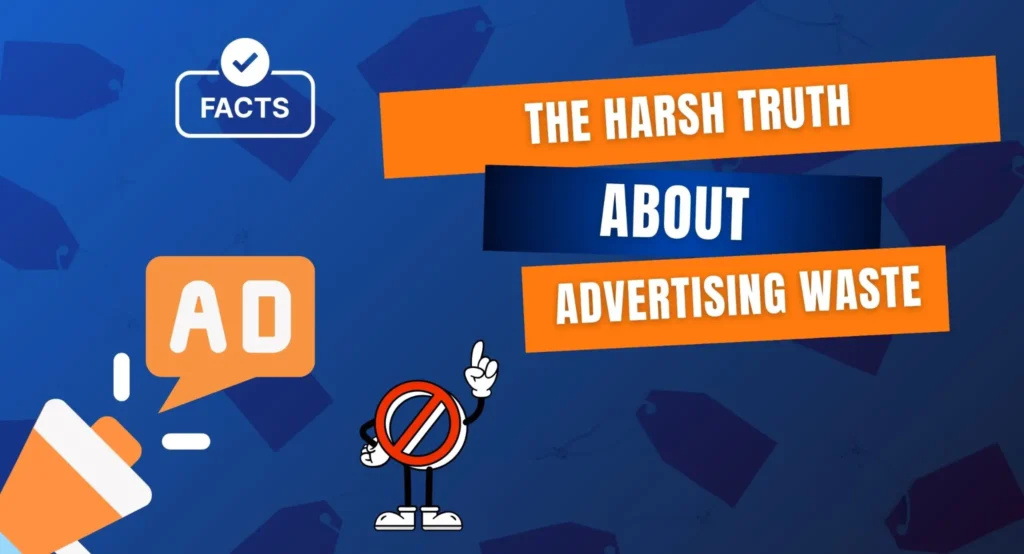
Common Mistakes That Lead to Wasting Money on Ads
If advertising is such a powerful growth tool, why do so many businesses struggle to see results? The answer is simple: most businesses fall into the same traps. These mistakes are common across industries, but they’re especially damaging in construction marketing, where ad clicks are expensive and customer decisions are high-stakes. Let’s break down the most common mistakes that cause companies to end up wasting money on ads.
1. Sending Traffic to Outdated or Weak Websites
One of the biggest advertising mistakes is running campaigns without first fixing the website. Imagine spending $20 per click to bring a homeowner to your site, only for them to land on a page that looks outdated, loads slowly, or doesn’t show proof of your work. That visitor is gone — and so is your ad spend.
For construction companies, credibility is everything. A homeowner searching for a roofing contractor wants to see project photos, customer reviews, and trust signals like licenses and certifications. If your ads drive traffic to a generic homepage without these elements, you’re essentially wasting money on ads that can’t convert.
2. No Clear Call-to-Action (CTA)
A surprising number of websites fail to tell visitors what to do next. A contractor might spend thousands driving traffic to their site, but if there’s no clear button that says “Request a Quote” or “Call Now,” visitors won’t take action.
Every ad click should lead to a specific next step. This could be filling out a form, scheduling a consultation, or calling directly. Without CTAs that stand out, businesses lose potential customers — and keep wasting money on ads that generate clicks but no leads.
3. Poor Audience Targeting
Targeting is where many ad campaigns go wrong. Business owners often cast too wide a net, paying for clicks from people who will never become customers.
Examples include:
- A remodeling company targeting the entire state instead of focusing only on the zip codes they actually serve.
- A roofing contractor paying for broad keywords like “construction” instead of specific ones like “roof leak repair Dallas.”
- A painting business showing Facebook ads to everyone in the city, instead of narrowing to homeowners over a certain age or income level.
Each of these scenarios results in wasted spend. Precise targeting is the difference between ads that work and wasting money on ads that never reach the right people.
4. Not Tracking Conversions Properly
Many businesses run ads without tracking what happens after the click. They know how many impressions or clicks they got, but they don’t know how many calls, form submissions, or contracts came from those ads.
This lack of data means they keep spending blindly. Without conversion tracking, businesses can’t tell which ads are profitable and which are wasting budget. For construction companies paying $15–$30 per click, this oversight can drain thousands every month.
5. Over-Reliance on Boosted Posts
Social platforms like Facebook and Instagram make it easy to “boost” a post with just a few clicks. Many businesses fall into this trap, thinking boosted posts are a real advertising strategy.
The truth? Boosted posts usually prioritize engagement — likes, comments, and shares — not conversions. A painting company might boost a post of a newly finished house and get hundreds of likes, but likes don’t pay the bills. Without proper targeting, boosted posts are just another way businesses end up wasting money on ads.
6. Ignoring Mobile Users
More than half of ad traffic comes from mobile devices, yet many construction company websites are not mobile-friendly. A slow-loading page, cluttered layout, or hard-to-use form will send mobile visitors away immediately.
If your ads aren’t backed by a mobile-optimized site, you’re not just losing leads — you’re wasting money on ads that will never convert.
7. Focusing on the Wrong Metrics
Clicks, impressions, and likes may look good in reports, but they don’t always translate to leads or revenue. Businesses that focus only on these vanity metrics are often disappointed when the phone doesn’t ring. The real measure of success is how many qualified leads and contracts come directly from ad spend.
The Bottom Line
Most businesses aren’t failing because ads don’t work. They’re failing because of poor execution. Weak websites, unclear CTAs, poor targeting, lack of tracking, and over-reliance on boosted posts are the biggest reasons companies end up wasting money on ads.
The good news? Each of these mistakes can be fixed. In the next section, we’ll explore how improving web design and user experience can transform wasted ad spend into consistent, qualified leads.
Why Web Design Is the Foundation of Ad Success
When businesses think about advertising, their first instinct is usually to focus on the platform — Google Ads, Facebook Ads, Instagram, or even YouTube. But here’s the reality: no matter how much you spend on ads, if your website is weak, you are wasting money on ads.
Ads don’t close deals. Websites do. An ad can capture attention and bring a prospect to your site, but whether that click turns into a phone call or form submission depends entirely on what happens after the click. This is why web design is the true foundation of ad success.
The Problem With Sending Ads to Weak Websites
Imagine you’re a homeowner looking for a contractor to remodel your kitchen. You click on a promising Google ad, but when the site loads, you see:
- A cluttered homepage that doesn’t mention kitchens.
- No photos of past projects.
- A generic “Contact Us” page buried in the navigation.
- A phone number that’s hard to find.
Even if the contractor paid $20 for that click, you’re gone in seconds. That’s the perfect example of wasting money on ads because the website wasn’t built to convert visitors into leads.
Fast, Mobile-Friendly Websites Prevent Lost Leads
Most ad clicks now come from mobile devices. If a construction company’s site takes longer than three seconds to load or isn’t mobile-friendly, prospects will abandon it immediately. Ads can drive all the traffic in the world, but without speed and usability, conversions will suffer.
Investing in mobile-first, responsive design ensures that when someone clicks an ad, they can quickly see services, browse photos, and request a quote without frustration.
Dedicated Landing Pages Increase Conversions
One of the biggest web design mistakes is sending ad traffic to a homepage instead of a dedicated landing page. Homepages are built for general browsing, but ads target specific needs.
For example:
- A roofing ad should lead to a landing page focused on roof repair, complete with testimonials, warranty information, and a “Request a Free Inspection” button.
- A remodeling ad should land on a page highlighting kitchens or bathrooms, with project galleries and a form to schedule a consultation.
Dedicated landing pages create a direct path from ad to action, reducing the chances of wasting money on ads that don’t result in inquiries.
Trust Signals Build Confidence
In construction marketing, trust is everything. Even if a visitor clicks your ad, they won’t convert if your site doesn’t reassure them. This is where trust signals in web design come in:
- Before-and-after project photos.
- Verified reviews and testimonials.
- Badges for licensing, insurance, or industry certifications.
- Case studies with real client stories.
Without these elements, ads may generate clicks but not leads — another example of wasting money on ads.
Clear Calls-to-Action Guide Visitors
Strong web design doesn’t just look good; it guides visitors toward action. Every landing page should have a clear CTA like:
- “Get a Free Quote Today”
- “Schedule Your Consultation”
- “Call Now for Immediate Assistance”
Buttons should be large, noticeable, and repeated throughout the page. Without CTAs, visitors leave without taking action, and the money spent on ads is wasted.
User Experience Affects Ad ROI
Google Ads and Facebook Ads measure user experience after the click. If your bounce rate is high or your site delivers a poor experience, ad platforms may charge you more per click or reduce your visibility. This means bad web design doesn’t just hurt conversions — it makes ads more expensive.
By investing in user-friendly navigation, clean design, and fast load times, businesses improve both conversion rates and ad performance. This reduces the likelihood of wasting money on ads while increasing ROI.
Why Web Design Must Come First
Too many businesses launch ads hoping to fix their lead problem, when in reality, their website is the bottleneck. Ads amplify whatever’s already there. If your site is strong, ads generate leads. If your site is weak, ads magnify the weakness.
For construction businesses where each lead represents a high-value project, the stakes are even higher. Before increasing ad budgets, companies must first invest in conversion-focused web design.
The Bottom Line
Web design isn’t just about aesthetics — it’s the difference between a profitable ad campaign and wasting money on ads that never convert. A fast, mobile-friendly, trustworthy, and CTA-driven website ensures that every advertising dollar has the best chance of turning into real revenue.
Smarter Targeting and Budget Allocation
Even the best-designed ads won’t deliver results if they’re shown to the wrong people. Poor targeting and sloppy budget allocation are among the top reasons businesses end up wasting money on ads. Too many campaigns focus on broad audiences, irrelevant locations, or keywords that don’t align with real customer intent. For construction businesses, where each click can cost $10–$30, missteps in targeting can drain thousands of dollars with little to no return.
Why Targeting Matters More Than Budget
It’s tempting to believe that spending more solves the problem. But increasing your budget without fixing targeting is like pouring fuel into a car with no engine — you’re just burning money. The businesses that succeed aren’t necessarily the ones spending the most on ads, but the ones reaching the right people at the right time.
The Danger of Overly Broad Targeting
One of the most common advertising mistakes is setting campaigns to cover an area that’s too wide. A remodeling contractor based in Dallas might set their ads to reach all of Texas. Sure, the ad will get clicks, but many will come from homeowners hundreds of miles away who would never hire them. That’s a textbook case of wasting money on ads.
Instead, targeting should be hyper-local. Focus on serviceable zip codes, neighborhoods, or a defined radius around your office. This ensures your ad spend goes toward people who can realistically become customers.

Using High-Intent Keywords
Another way businesses waste money is by targeting generic, broad keywords. For example, running ads for the word “remodeling” may generate clicks, but most of those searchers aren’t ready to buy. Compare that to “kitchen remodeling contractor near me” — a high-intent keyword that indicates the searcher is actively looking for help.
For construction businesses, focusing on high-intent keywords drastically reduces wasted spend. Instead of paying for casual browsers, you’re paying for clicks from people ready to hire.
Smarter Budget Allocation
Throwing equal budget across all campaigns is another way businesses lose money. Not all services or keywords are created equal. A roofing contractor may get far more ROI from “emergency roof repair” than “roof replacement financing.” If budgets aren’t adjusted accordingly, you risk overspending on low-value leads while underspending on high-value ones.
AI-powered ad platforms can help here, automatically shifting budget toward the campaigns, keywords, and audiences that generate conversions. But human oversight is still essential — especially for small businesses. Owners and marketers need to evaluate which services generate the most profit and align budgets accordingly.
The Power of A/B Testing
Another often-overlooked tactic is A/B testing. Too many businesses run one version of an ad and let it run indefinitely. If it fails, they assume ads don’t work. In reality, small changes can have a massive impact:
- Headline A: “Trusted Kitchen Remodelers in Houston”
- Headline B: “Transform Your Kitchen in 30 Days”
One headline might generate double the clicks and conversions of the other. Without testing, you’ll never know — and you’ll keep wasting money on ads that underperform.
Avoiding Vanity Targeting Metrics
Some businesses waste budget by chasing the wrong goals. For instance, aiming for maximum impressions may look impressive in reports, but impressions don’t always lead to conversions. A roofing contractor doesn’t benefit from thousands of people seeing their ad — they benefit from qualified homeowners clicking, calling, and booking inspections.
This is why smarter targeting and budget allocation focus on conversions, not vanity metrics. Every dollar spent should tie back to a measurable outcome: calls, form submissions, or contracts.
Why This Matters for Construction Businesses
In construction, each job represents a significant investment. Wasting even a few hundred dollars a month on poor targeting means losing out on potentially thousands in project revenue. By focusing budgets on the most profitable services, narrowing targeting to actual service areas, and prioritizing high-intent keywords, construction companies can turn ads from an expense into a reliable lead engine.
The Bottom Line
Ad success isn’t about how much you spend — it’s about how smartly you spend it. Poor targeting and sloppy budgets are two of the biggest reasons businesses are wasting money on ads. By refining audience targeting, prioritizing high-intent keywords, testing variations, and aligning budgets with profitable services, you can dramatically improve ROI and stop wasting precious ad dollars.
Tracking and Measuring What Matters
One of the most overlooked reasons businesses end up wasting money on ads is the lack of proper tracking. Many owners judge the success of their ad campaigns on surface-level metrics — clicks, impressions, or likes — without understanding whether those clicks actually turned into phone calls, quote requests, or signed contracts. Without accurate tracking, ad campaigns become guesswork.
Vanity Metrics vs. Real ROI
Clicks and impressions may look impressive in a report, but they don’t necessarily mean money in the bank. For example:
- A remodeling company’s ad generates 2,000 clicks in a month. On paper, that sounds like success.
- But if only five people filled out the contact form and none became paying customers, the ROI is negative.
This is why tracking actual conversions — not just engagement — is critical. If you don’t know which campaigns produce real revenue, you’re wasting money on ads that look good but don’t perform.
The Importance of Conversion Tracking
Conversion tracking is the process of monitoring what happens after someone clicks on your ad. For construction businesses, this might include:
- Phone calls made directly from the ad.
- Contact forms submitted on landing pages.
- Appointments scheduled through an online booking system.
- Quote requests submitted via dedicated forms.
By setting up conversion tracking, you can identify which ads are producing real business opportunities and which ones are draining your budget.
Call Tracking for Service Businesses
In the construction industry, most leads come through phone calls. That means tracking calls generated by ads is essential. Call tracking tools assign unique numbers to each ad campaign, so you can see exactly which campaigns drive phone inquiries.
For example:
- A roofing contractor may discover that 70% of calls come from ads focused on “emergency roof repair” while very few come from “roof replacement financing.”
- This insight allows them to shift budget toward the high-performing ads and stop wasting money on ads that don’t convert.
Using Analytics to Refine Campaigns
Platforms like Google Analytics and Facebook Ads Manager provide detailed insights into user behavior after the click. Key metrics to monitor include:
- Bounce Rate: How many visitors leave immediately without engaging? A high bounce rate means your landing page isn’t delivering.
- Time on Page: Are people actually reading or just skimming? Short visits indicate weak content or poor alignment with ad promises.
- Conversion Rate: What percentage of clicks result in leads? Low conversion rates often point to poor design or unclear CTAs.
By analyzing these data points, you can make informed adjustments instead of guessing. This is how companies stop wasting money on ads and start optimizing for real ROI.
Setting Up Goals in Google Analytics
Another critical step is setting up goals in Google Analytics. Goals can be configured to track actions like form submissions, phone calls, or downloads. By linking these goals to ad campaigns, you can directly measure how many conversions came from each ad and calculate cost per lead.
For example, if a remodeling contractor spends $1,000 on ads and gets 25 qualified leads, their cost per lead is $40. If they close just a few of those leads into jobs worth thousands, the ROI is clear. Without this data, the same $1,000 might look like a loss.
Why Tracking Is Non-Negotiable
Without tracking, businesses rely on gut feelings to judge campaigns. They might continue running ads that generate clicks but no leads, while shutting down campaigns that quietly produce high-value contracts. This lack of clarity is one of the biggest reasons businesses keep wasting money on ads.
Construction companies, in particular, cannot afford this blind approach. With high cost-per-click rates and long sales cycles, precise tracking is the only way to ensure ad spend produces tangible results.
The Bottom Line
Ads without tracking are like building a house without blueprints — you’re guessing, and mistakes are expensive. The difference between profitable campaigns and wasting money on ads often comes down to tracking the right metrics: phone calls, form submissions, and signed contracts. By setting up proper conversion tracking, call tracking, and analytics, businesses can make data-driven decisions that maximize ROI and eliminate unnecessary waste.
Case Study: From Wasting Money on Ads to Generating Real Leads
Sometimes the best way to understand the impact of wasted ad spend — and how to fix it — is through a real-world scenario. Let’s look at a common case many construction companies face.
The Problem: Money Spent, No Results
A mid-sized remodeling company in Houston was spending around $2,000 per month on Google Ads. They were bidding on competitive keywords like “kitchen remodeling,” “bathroom remodeling,” and “home renovation near me.” At first glance, the campaign looked healthy. They were generating about 300 clicks every month, which averaged out to roughly $6.50 per click.
But here’s the catch: the phone wasn’t ringing. Out of those 300 visitors, fewer than 10 filled out the contact form, and even fewer turned into consultations. Month after month, they were wasting money on ads that weren’t bringing real clients through the door.
Diagnosis: Why the Ads Failed
When the campaign was audited, several issues became clear:
- Generic Landing Pages: All ad traffic went straight to the homepage, which was cluttered and didn’t highlight specific services.
- Weak Calls-to-Action: The site had a small “Contact Us” button buried in the footer, with no urgency or incentive for prospects to act.
- Poor Targeting: Ads were running across the entire Houston metro area, including neighborhoods far outside the company’s service radius.
- No Tracking: The business wasn’t tracking calls or form submissions from ads, so they had no idea which campaigns (if any) worked.
In other words, they were paying for clicks without creating a path for conversions.
The Fix: Building a Stronger Foundation
Here’s how the campaign was turned around:
- Dedicated Landing Pages: Instead of sending clicks to the homepage, separate landing pages were created for kitchens, bathrooms, and whole-home remodeling. Each page included project galleries, testimonials, and a bold call-to-action (“Get Your Free Consultation Today”).
- Clear CTAs and Forms: Prominent buttons and short forms were added throughout the site to capture leads quickly. A phone number was also added in the header with click-to-call functionality for mobile users.
- Geo-Targeting: Ads were restricted to a smaller radius covering only the neighborhoods the company actually served. This reduced wasted spend on irrelevant clicks.
- Call Tracking: Unique phone numbers were assigned to each campaign, so the business could see exactly how many calls were coming from their ads.
- A/B Testing: Headlines, images, and ad copy were tested to identify which variations generated the most clicks and conversions.
The Results: From Waste to ROI
Within three months of these changes:
- The conversion rate jumped from under 3% to over 12%.
- Monthly leads increased from 8 to nearly 40 — without raising the budget.
- Cost per lead dropped from $250+ to around $50.
- The company booked several high-value remodeling jobs, turning ads from a money drain into a reliable growth engine.
The difference was dramatic. They went from wasting money on ads to running campaigns that consistently generated profitable leads.
Lessons for Other Businesses
This case study illustrates a simple truth: ads don’t work in isolation. They only succeed when combined with strong web design, smart targeting, and proper tracking. Without these elements, even the biggest budget will be wasted.
For construction companies — where each job can be worth thousands — the stakes are even higher. Fixing wasted ad spend doesn’t always mean spending more; it means spending smarter.
The Bottom Line
Real results come from strategy, not just ad dollars. By creating dedicated landing pages, narrowing targeting, adding clear calls-to-action, and tracking performance, businesses can stop wasting money on ads and finally turn campaigns into consistent lead generators.
Building Ads Into a Larger Marketing Strategy
One of the biggest reasons businesses end up wasting money on ads is that they treat advertising as a stand-alone solution. When sales dip, the reflex is to throw more money at Google Ads or boost a few posts on Facebook. While ads can absolutely drive traffic and leads, they should never be the only marketing tactic. Successful businesses understand that advertising works best as part of a larger, integrated strategy.
Ads Alone Are Not Enough
Think of ads as fuel for your marketing engine. If your engine — your website, brand positioning, and overall digital presence — is weak, the fuel won’t take you very far. Ads may generate clicks, but without SEO, content marketing, and strong branding, your visibility vanishes as soon as you stop paying.
Construction companies in particular face this issue. Many rely heavily on ads but neglect their organic search rankings, online reviews, or social proof. This creates a cycle where they are forever dependent on ad spend, essentially renting visibility instead of owning it. The result? A long-term pattern of wasting money on ads.
Combining Ads With SEO
Search engine optimization (SEO) is the long-term partner to paid ads. While ads can generate quick traffic, SEO builds credibility and brings in ongoing leads without paying for every click. A balanced strategy might look like this:
- Use ads to immediately drive traffic for high-value services (e.g., “emergency roof repair Houston”).
- Build SEO content around those services — blogs, FAQs, and project pages — to capture organic traffic over time.
- Over months, reliance on ads decreases as organic rankings climb, reducing wasted ad spend.
Without SEO, every lead depends on ongoing ad spend. With SEO, ads amplify what’s already ranking, creating a sustainable mix.
Integrating Ads With Content Marketing
Content marketing — blogs, videos, and case studies — gives your ads more weight. For example:
- A remodeling company could run an ad promoting a blog titled “Top 5 Kitchen Remodeling Trends in 2025.”
- A roofing contractor could advertise a storm damage checklist PDF in exchange for an email address.
- A window installer could use video ads showcasing before-and-after transformations.
This type of integration not only increases conversions but also positions the business as an authority. Instead of wasting money on ads that simply shout “buy now,” businesses provide value first, building trust and credibility.
Reputation and Reviews: The Overlooked Partner
For construction companies, online reviews are often the deciding factor for customers. Ads might bring someone to your site, but reviews convince them to act. An integrated strategy ensures ads highlight 5-star reviews, testimonials, or case studies. This creates a seamless journey: ad → website → proof → conversion.
When reviews are ignored, even great ads can flop. Homeowners will click, research your business, see a lack of reviews, and move on. That’s another way companies end up wasting money on ads — neglecting the social proof customers demand.
Ads as Part of a Full Funnel
Instead of treating ads as one-time pushes, businesses should use them strategically across the sales funnel:
- Top of Funnel (Awareness): Promote blogs, guides, or videos to educate potential clients.
- Middle of Funnel (Consideration): Retarget visitors with ads showing testimonials or project portfolios.
- Bottom of Funnel (Decision): Run lead-gen ads with strong CTAs like “Book a Free Estimate Today.”
This layered approach ensures that no click is wasted. Even if a visitor doesn’t convert the first time, retargeting ads and supporting content bring them back until they’re ready to buy.
Why Integration Saves Money
When ads work alongside SEO, content, and reviews, businesses maximize every dollar. Leads are nurtured across multiple touchpoints instead of relying on one ad to close the deal. This reduces the cost per lead and minimizes the risk of wasting money on ads that don’t align with the bigger picture.
The Bottom Line
Ads are powerful, but they’re not magic. Businesses that rely on ads alone are destined to overspend and underperform. The key to stopping wasting money on ads is building them into a larger marketing system — one that includes SEO, content, reviews, and strong web design. When ads amplify an already solid foundation, they become an investment that compounds over time, not just an expense that disappears at the end of each month.
Conclusion: Stop Wasting Money on Ads and Start Driving Real Results
At this point, the message should be clear: most businesses are wasting money on ads not because advertising itself doesn’t work, but because the foundation around those ads is broken. Without a conversion-focused website, clear calls-to-action, proper targeting, and accurate tracking, every click is just another dollar lost. For industries like construction, where every lead could turn into a high-value project, wasted ad spend isn’t just frustrating — it’s costly.
The Key Takeaway
Running ads without strategy is like building a house on sand. The structure might look good for a while, but it won’t hold. Ads must be supported by strong web design, precise targeting, and continuous tracking to deliver ROI. Businesses that treat ads as a quick fix will keep wasting money on ads, while those that build a long-term system will see consistent growth.
Why Construction Businesses Can’t Ignore This
For contractors, remodelers, roofers, and home service providers, ad costs are rising every year. High-intent keywords like “roof repair near me” or “kitchen remodeling contractor” are among the most competitive in digital marketing. That means every wasted click is expensive. The companies that win will be the ones that stop guessing, start tracking, and use ads as part of a bigger marketing ecosystem that includes SEO, content, and reviews.
Your Next Step
The good news is that fixing wasted ad spend doesn’t always mean spending more. Often, it means spending smarter:
- Designing dedicated landing pages for each service.
- Tightening targeting to your actual service area.
- Using high-intent keywords that bring in ready-to-buy customers.
- Setting up tracking to measure real ROI.
At Rynox Digital, we specialize in helping construction businesses stop wasting money on ads and start turning campaigns into reliable lead generators. Our approach combines expert web design, smart ad management, and data-driven strategies that ensure every dollar works harder for your business.
Ready to stop wasting money on ads? Schedule a free consultation today and discover how we can transform your ad spend into consistent leads, steady growth, and a stronger online presence.
Stop wasting money on ads.
Partner with Rynox Digital and turn every click into real leads.

